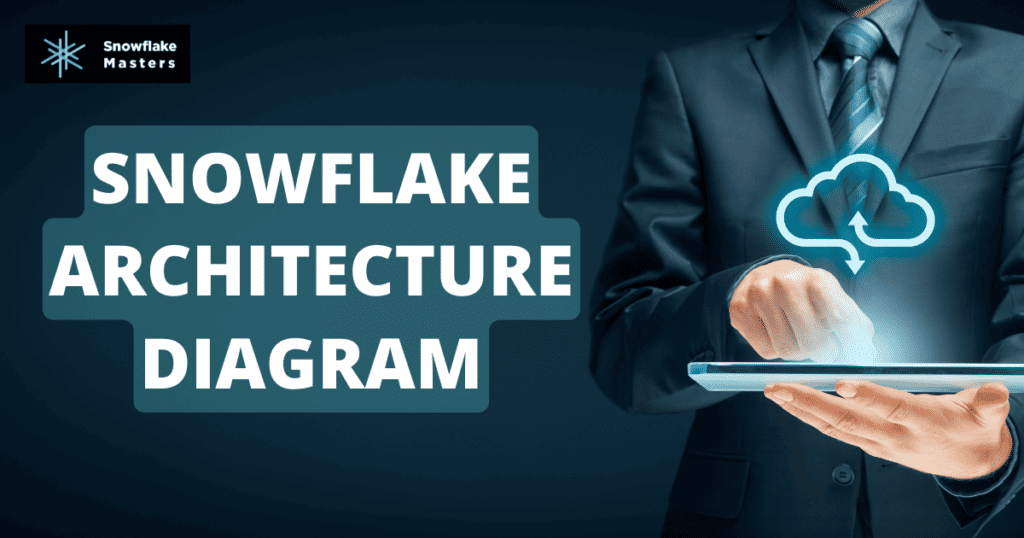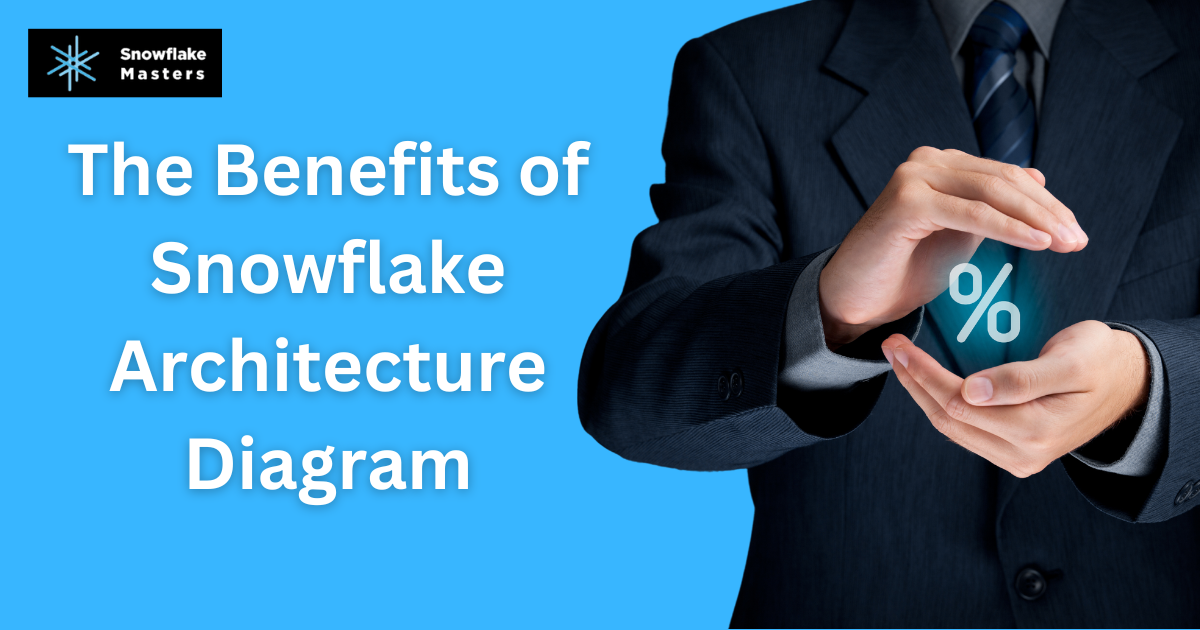Breaking Down the Components of Snowflake Architecture Diagram: A Step-by-Step Guide
Snowflake Architecture Diagram Explanation

In today’s fast-paced business environment, data is everything. Companies need to store, manage, and analyze vast amounts of data to gain insights to help them make informed decisions.
That is where data warehousing comes in. A data warehouse is an organized repository that holds data from various places. And makes it available for analysis. However, traditional data warehousing solutions can be expensive, complex, and time-consuming to set up and maintain.
Enter Snowflake Architecture, a cloud-based data warehousing solution gaining popularity due to its scalability, flexibility, and ease of use. This article will explore why Snowflake Architecture is the best solution for your data warehousing needs.
Snowflake Architecture also supports data sharing capabilities, allowing businesses to share their data securely with partners, customers, or any other stakeholders in real-time. This feature ensures that data collaboration is seamless and efficient, without the need to create multiple copies of the data. With Snowflake, users can access the shared data directly from the platform, ensuring consistency and accuracy across the board. Additionally, Snowflake’s architecture supports diverse workloads, from data warehousing and data lakes to data science and data application development, making it the best choice for various data needs.
Another advantage of Snowflake is its built-in support for various data integration and business intelligence tools. This ensures that businesses can continue using their preferred tools and workflows without disruption. Snowflake also offers data governance features, including role-based access controls and comprehensive auditing capabilities, which help organizations maintain compliance with regulatory requirements. As a result, businesses can confidently depend on Snowflake to manage their data securely and efficiently, empowering them to make data-driven decisions and drive growth.
Table of contents
- What is Snowflake Architecture?
- What is the Snowflake Architecture Diagram?
- Is Snowflake Architecture Easy to Use?
- The Benefits of Snowflake Architecture
- Scalability Flexibility Performance
- Cost Effectiveness
- Security
- How Snowflake Architecture Works
- Is Snowflake Architecture secure?
- What industries can benefit from the Snowflake?
- Conclusion
What is Snowflake Architecture?
Snowflake Architecture is a cloud-based data warehousing solution that separates storage and compute resources. This unique architecture allows companies to scale their resources independently and avoid infrastructure management. Snowflake Architecture has been built to handle organized and semi-structured data and unstructured data formats such as JSON, Avro, and XML.
They have been designed to be easy to use, with a user-friendly interface and several tools and features to help companies manage their data warehousing needs. Snowflake Architecture is SOC 2 Type II certified, which meets strict security and privacy standards.
To protect data, it utilizes encryption during rest and in transit.
Snowflake Architecture’s unique architecture and design make it a powerful and effective solution for modern data warehousing needs.
What is the Snowflake Architecture Diagram?
Snowflake Architecture is a cloud-based data warehousing solution fount in 2012. It is a fully-managed service that allows companies To protect data; it utilizes encryption during rest and in transit. Securely and scalable. Snowflake uses a unique architecture separating storage and computing, allowing companies to scale up or down as needed without worrying about infrastructure management.
That enables businesses to increase their resources independently while avoiding infrastructure management. The Snowflake Architecture originated to handle structured, semi-structured, and unstructured data formats such as JSON, Avro, and XML. That service was engineered to be simple to use, with a user-friendly interface and various tools and functions to assist businesses in managing their data warehousing requirements.
Snowflake Architecture is SOC 2 Type II certified, which meets strict security and privacy standards. To protect data, it utilizes encryption during rest and in transit. Pricing for Snowflake Architecture based on a pay-as-you-go model means that companies only pay for the resources they use.
Snowflake Architecture offers several benefits over traditional data warehousing solutions, including scalability, flexibility, high performance, cost-effectiveness, and security. Snowflake is poised to become the go-to option for data warehousing as data becomes increasingly vital in business.
Is Snowflake Architecture Easy to Use?
User-friendly interface: The Snowflake Architecture has a modern, user-friendly design that makes it easy to obtain and use. Users can easily create databases, tables, and views and run queries using SQL or Snowflake web interface.
Scalability: Users can scale resources up and down as needed without having to worry about infrastructure maintenance. Snowflake includes extensive documentation and support to assist users in getting started and troubleshooting any issues that may arise. That makes it easy to adjust resources to meet changing business needs.
Integration options: Snowflake provides several integration options, including connectors for popular data integration and visualization tools like Tableau, Power BI, and Informatica. That makes integrating Snowflake with existing workflows and tools easy.
Documentation and support: Snowflake offers extensive documentation and support to assist customers in getting started and troubleshooting any issues. The documentation includes tutorials, how-to guides, and best practices, while support is available via email, phone, or chat.
Overall, the simplicity of use of Snowflake Architecture Diagram makes it an appealing alternative for companies that require a strong and easy information storage system that is simple to use and manage.
The Benefits of Snowflake Architecture Diagram
Snowflake Architecture has several benefits for your data warehousing needs. Let’s take a closer look at some of them.
Scalability: One of the biggest advantages of the Architecture Diagram is its scalability. Companies can readily scale up or down computing and storage power based on their need. That means they can handle large amounts of data without worrying about infrastructure management.
Snowflake Architecture also allows for automatic scaling, meaning it can automatically adjust resources based on usage patterns.
According to a study by Forrester, companies that use Snowflake Architecture can achieve a 604% return on investment (ROI) over three years. That is due in large part to the scalability of the platform.
Flexibility: Another advantage of the Snowflake Architecture is its flexibility. It can handle structured, semi-structured, and unstructured data such as JSON, Avro, and XML. Companies can store and analyze various data types in a single platform.
Performance: Snowflake Architecture had designed for high performance. It uses a columnar storage format that allows for fast queries and analytics. In addition, Snowflake uses a technique called micro-partitioning, which allows it to process data in parallel across multiple nodes.
That means that queries can be processed quickly and efficiently, even when dealing with huge amounts of data.
According to a study by GigaOm, Snowflake Architecture outperformed traditional data warehousing solutions by up to 200x in some cases.
Cost-Effectiveness: Snowflake is a cost-effective solution for data warehousing. It uses a pay-as-you-go pricing model, which means that companies only pay for the resources they use.
That eliminates the need for upfront capital expenditures and allows companies to scale their data warehousing costs based on their needs.
According to a study by IDC, companies that use Snowflake Architecture Diagram can achieve a 25% reduction in data warehousing costs compared to traditional solutions.
Security: Snowflake Architecture takes security seriously. It is SOC 2 Type II certified and meets strict security and privacy standards. It also uses encryption at rest and in transit to protect data.

How Snowflake Architecture Diagram Works
Snowflake uses a unique architecture that separates storage and computing. Data were stored in a centralized repository called the Snowflake Architecture database, while compute resources were provisioned as needed. That allows companies to scale their computing resources independently of their storage resources, which can lead to significant cost savings.
Snowflake also employs multi-cluster warehousing, enabling it to process parallel queries across numerous clusters. Thus, queries may be executed rapidly and effectively, even when dealing with massive data. Consequently, searches could have been done quickly and efficiently even when dealing with huge amounts of data.
Snowflake Architecture evolved to be simple to use, with a user-friendly interface and various capabilities and features to help enterprises manage their data warehousing needs. They also handled structured, semi-structured, and unstructured data such as JSON, Avro, and XML. Snowflake Architecture is SOC 2 Type II certified, which meets strict security and privacy standards.
Is Snowflake Architecture Diagram secure?
It employs encryption both at rest and in transport to protect data. Pricing for Snowflake Architecture based on a pay-as-you-go model means that companies only pay for the resources they use. Overall, Snowflake Architecture unique architecture and design make it a powerful and effective solution for modern data warehousing needs.
Yes, Snowflake takes security seriously. It is SOC 2 Type II certified and meets strict security and privacy standards. It also uses encryption at rest and in transit to protect data. Snowflake Architecture implements several security measures to ensure authorized users can access data, such as multi-factor authorization, IP-allow listing, and role-based access control.
It also provides audit trails and logs to track user activity and monitor suspicious behaviour. Overall, Snowflake Architecture is a highly secure data warehousing solution that provides peace of mind to companies that need to store and manage sensitive data.
What industries can benefit from Snowflake Architecture ?
Finance: Financial institutions deal with large amounts of data, including transaction data, market data, and customer data. Snowflake Architecture can help finance companies manage this data securely and efficiently while providing real-time analytics and insights.
Healthcare: Healthcare companies deal with large amounts of sensitive patient data, including medical records, insurance information, and billing data. Snowflake Architecture security and privacy features make it an ideal solution for managing this data.
Retail/E-commerce: Retail and e-commerce companies deal with large amounts of customer data, including transaction data, customer behavior data, and inventory data. Snowflake Architecture Diagram can help these companies manage this data and gain insights into customer behaviour and preferences.
Advertising: Advertising companies deal with large amounts of data related to ad performance, customer behavior, and market trends. Snowflake can help these companies manage this data and gain insights into ad performance and customer behaviour.
Government: Government agencies deal with large amounts of citizen services, public safety, and national security data. Snowflake Architecture Diagram’s security features make it an ideal solution for managing this sensitive data.
These are just a few industries in which the Snowflake Architecture Diagram can be useful. This durable and flexible data warehousing system may help any industry with big amounts of data.

Conclusion
Snowflake Architecture Diagram is a cloud-based data warehousing solution offering several benefits over traditional ones. It is scalable, flexible, high-performing, cost-effective, and secure. Its unique architecture separates storage and computing, which allows companies to scale their resources independently and avoid infrastructure management. Companies that use Snowflake Architecture can achieve significant ROI and cost savings and gain valuable insights from their data. Snowflake Architecture is poised to become the go-to option for data warehousing as data plays an increasingly vital role in business.
FAQ’s
Snowflake Architecture Diagram is a cloud-based data warehousing solution that allows companies to store, manage, and analyze large amounts of data securely and scalable.
Snowflake Architecture Diagram offers several benefits over traditional data warehousing solutions. It is scalable, flexible, high-performing, cost-effective, and secure. Its unique architecture separates storage and computing, which allows companies to scale their resources independently and avoid infrastructure management.
Snowflake Architecture Diagram uses a unique architecture that separates storage and computing. Data is stored in a centralized repository called the Snowflake Architecture Diagram database, while compute resources are provisioned as needed. That allows companies to scale their computing resources independently of their storage resources, which can lead to significant cost savings.
Snowflake Architecture Diagram can handle structured, semi-structured, and unstructured data such as JSON, Avro, and XML. Companies can store and analyze various data types in a single platform.
Yes, Snowflake Architecture Diagram takes security seriously. It is SOC 2 Type II certified and meets strict security and privacy standards. It also uses encryption at rest and in transit to protect data.
Snowflake Architecture Diagram uses a pay-as-you-go pricing model, meaning companies only pay for the resources they use. Pricing varies based on the quantity of data stored and computing resources used.
Snowflake Architecture Diagram offers several advantages over traditional data warehousing solutions. It is more scalable, flexible, and cost-effective. It also offers better performance, particularly when dealing large amounts of data
Yes, the Snowflake Architecture Diagram had designed to be simple. Its user-friendly interface provides various tools and capabilities to assist businesses in managing their data warehousing requirements.
Yes, Snowflake Architecture had designed to handle big data. As a result of its unique architecture, it can process queries quickly and quickly, even when dealing with enormous quantities of data.
Snowflake Architecture Diagram offers several advantages over traditional data warehousing solutions. It is more scalable, flexible, and cost-effective. It also offers better performance, particularly when dealing large amounts of data
Snowflake Architecture Diagram can help any industry that deals with large amounts of data. Finance, healthcare, retail, and other industries are among them.
